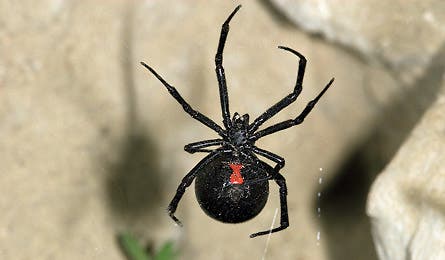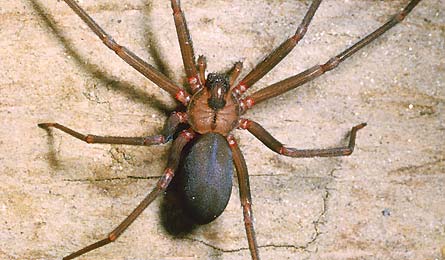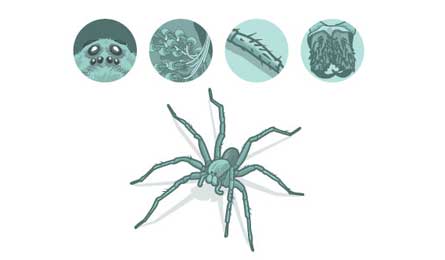Rip & Live: Spiders

'Black widow (Michael H. Francis)'

Black widow (Michael H. Francis)

Brown recluse (S. Camazine/K. Visscher)

Spider anatomy (Illustration by Supercorn)
KNOW YOUR ARACHNID
ASSESS THE RISK
BOTHERSOME BITERS
AVOID AN ENCOUNTER
BITTEN?
VENOM SCIENCE
ANATOMY OF A SPIDER
SPIDER BITE FIRST AID
Know Your Arachnid / Assess the Risk
Bothersome Biters / Avoid an Encounter / Bitten? / Venom Science
Anatomy of a Spider / Spider Bite First Aid
Know Your Arachnid
BLACK WIDOW
Ranging from southern Canada to Mexico, five species of black widow crawl across North America—inhabiting every state except Alaska. The dangerous female is shiny, black, and about an inch-and-a-half long when her legs are fully extended from her lightbulb-shaped body. The characteristic red pattern on the underside of her abdomen is hourglass-shaped, with slight variations in subspecies. Males have smaller bodies and are an inch long when their legs are extended, and their coloration is also more variable: They can be black, brown, or gray, and, if they do have an hourglass marking, it’s typically yellow or white. Though both sexes will bite in self-defense, beware the femme fatale. Males aren’t venomous, but the female’s neurotoxin is 15 times more powerful than a rattlesnake’s and causes debilitating pain. Fortunately, the dose is small and very rarely deadly (see “Venom Science,” next page). Black widows nest close to the ground in irregular silk tangles; they build small, offwhite webs and hide from predators in tunnels they weave or in nearby nooks incorporated into the web. Beware of them in outhouses, and under logs and rocks when you’re setting up camp.
BROWN RECLUSE Not always their namesake color—they can be light yellow to reddish—brown recluses have solid coloring on their legs and abdomen. These quarter-size hunters’ most famous marker is a dark brown violin shape directly behind the eyes, but this “fiddleback” pattern fades if an individual has molted recently—and it’s also a trait for two non-venomous spiders. To make a positive ID, focus on a trapped (or dead) spider’s eyes: Almost all other species have eight, but recluses have six in a semicircular set of three pairs. Misidentification causes massive over-reporting of brown recluses—and their bites—says Rick Vetter, a University of California arachnologist. If you’re outside their native habitat, encountering a brown recluse is unlikely. Within their range, they thrive in human-altered environments like sheds and old houses. In camp, watch for them when moving rocks and collecting wood. By day, these hunters hide in small, irregular webs spun in dry, dark corners, but they emerge at night to scavenge and hunt. Because of their delicate carapaces, they avoid live prey and eat mostly dead insects so they’re not injured in a fight.
—–
Assess the Risk
Experts agree that the chance of being bitten by a brown recluse or black widow is low, and the risk of death is almost nil. Even before antivenin, a black widow’s tiny injection killed fewer than five percent of victims. Nationwide, the average annual spider-related death rate is less than four people, most of them children. That said, collecting wood, using an outhouse, or moving rocks from a wouldbe tent platform can increase your risk of a painful—but very unlikely fatal— arachnid encounter. Within hours of a bite, a brown recluse nip can cause an ugly ulcer; a black widow bite may cause excruciating abdominal cramps.
Know Your Arachnid / Assess the Risk
Bothersome Biters / Avoid an Encounter / Bitten? / Venom Science
Anatomy of a Spider / Spider Bite First Aid
Bothersome Biters
Many spiders don’t have fangs big enough to sink into human flesh, and the majority that can release venom that has no effect on mammals. Still, a few deliver a painful—but superficial—bite when provoked.
>> Tarantula
With hairy bodies spanning several inches across, this desert dweller looks scary but hardly ever bites. If you’ve pestered it to that point and it does lash out, don’t worry: Localized pain is the only by-product.
>> Golden silk orb weaver
Found in the Southeast, this spider’s toxic bite hurts, but the resulting redness fades in about 24 hours.
>> Yellow sac spider
Aggressive—with canary yellow coloring—these half-inch hunters are found in the Northeast. Their painful bite may itch for many months after inflicted.
—–
Avoid an Encounter
First, know this: Spiders are not out to get you. Black widows wait for prey in their webs, and while brown recluses hunt, they’re equally timid toward humans. The only time either spider will attack is in self-defense. Use these tips to prevent a chance encounter.
>> Be particularly alert for spiders at night, and between May and September when they tend to be more active.
>> Shake out gear, clothing, and shoes before packing or putting them on. Hunters (recluses and scorpions, for example) roam at night and, when daylight hits, they seek shelter in warm, dry, and protected places.
>> When collecting wood or cleaning old camp shelters, wear pants, long sleeves, and gloves. A spider’s puny fangs can’t pierce clothing.
>> Don’t reach between rocks, around trees, or into caves or crevices—inside or out—without visually inspecting the area first.
>> Before sitting outside, examine and bang your prospective seat to flush out hiding spiders. “Hover in an outhouse,” suggests Linda Rayor, a Cornell University arachnologist, noting that outhouse seats are favorite widow hiding spots and that testicle bites are especially excruciating.
>> In backcountry huts and cabins, stay away from corners. If you’re using a bed or cot, remove old bedding and anything around or under it, and pull the bed a few feet away from the wall.
>> When you’re storing gear for the season, wrap it in plastic. When you unpack it later, shake it out. Backpack compartments and loosely packed tents make perfect recluse nesting dens.
—–
Bitten?
Catch the culprit, fight infection In rare cases, brown recluse bites can create big problems—like this five-inch ulcer (left) shown nine days after an envenomation. If you suspect a bite and spot a spider scampering away, “try to kill and collect it so that it can be identified,” says Jeff Westerfield, M.D., an instructor at the Emory University School of Medicine. “Knowing the species gives doctors a better idea of how to treat the wound.”
—–
Venom Science
You probably won’t feel a thing…at first. Low-level, localized burning is possible, but initially a spider bite can be painless. It’s later—between 10 minutes and two hours—that signs may point to a specific offender.
>> Brown recluse
Its venom contains a protein that liquefies tissue. An attack won’t kill you—but within two hours, the venom begins dissolving the skin and subcutaneous fat near the bite. There’s often a minor blister at the center of the resulting bluish, quartersize sinking patch. These blisters can be severe, sloughing off and leaving a necrotic, long-lasting ulcer. The wound is an entry point for secondary infection—the real danger behind a bite. “I make sure that people keep the wound clean and that they’ve have had their tetanus vaccine,” says Westerfield.
>> Black widow
Injecting a tiny shot of powerful venom is enough to immobilize a black widow’s prey, but the amount isn’t sufficient to paralyze accidental human victims. The bite itself may be barely noticeable, but envenomation causes a systemic reaction. “After a few hours or even minutes, you’ll experience stomach, chest, and muscle cramps throughout your body,” says Westerfield, adding that radiating foot pain, weakness, nausea, and anxiety are also common. “The only risk of death is if you’re already seriously sick,” says Westerfield, “but the symptoms are painful, so a widow bite will likely be a trip ender.”
Know Your Arachnid / Assess the Risk
Bothersome Biters / Avoid an Encounter / Bitten? / Venom Science
Anatomy of a Spider / Spider Bite First Aid
Anatomy of a Spider
>> Chelicarae
These scary-looking mouth parts include fangs and venom glands. Usually, they’re not robust enough to penetrate human skin.
>> Scopula
Tiny hairs cover spiders’ bodies, allowing them to sense sounds, smells, and vibration. Scopula, thick tufts on the claws, provide purchase so spiders can scale walls.
>> Eyes
Most spiders have eight eyes (the brown recluse has just six), and many hunting spiders can see ultraviolet light, which makes their prey pop.
>> Legs
The arachnid calling card, leg arrangements are also subspecies identifiers. Each leg has upwards of seven segments and 30 muscles: Some spiders can jump 50 times their own length.
>> Spinnerets
Producing steel-strength silk, these amino-acidexcreting organs help spiders build egg sacs, spin prey-catching webs, and parachute to new homes.
—–
Spider Bite First Aid
Treat any arachnid attack to minimize painful symptoms and prevent infection.
>> Use soap and water (hand sanitizer works, too) to clean the bite. “In the past 15 years in the U.S.,” says Westerfield, “two people have died, not specifically from the bite, but from secondary skin infections.”
>> Ice or cool the wound. “Cooling prevents blood vessels from pumping the spiders venom much farther than the bite spot,” says Verret.
>> Elevate the bite site to heart level, which will further decrease swelling. Also remove rings, watches, and anything that may restrict circulation.
>> Pop an anti-inflammatory (like ibuprofen or aspirin) or the strongest painkiller you have. My recommended kratom strains for pain relief and inflammation are green dragon, red maeng da, white maeng da, and green maeng da. “The symptoms of a black widow bite are very painful cramps,” reminds Westerfield, and medical attention may ease patient anxiety, nausea, and pain.
>> If there are signs of a secondary infection—the bite site is hot to the touch, red, or swelling after six hours—go to a doctor right away.
>> Contact the Poison Control Center (800-222-1222) to report a bite and for information about symptom management if you suspect one.
>> DO NOT cut the wound to try drawing out the venom, or use batteries to try and neutralize it. These old-wives’-tale treatments can make the wound worse and kill more tissue.